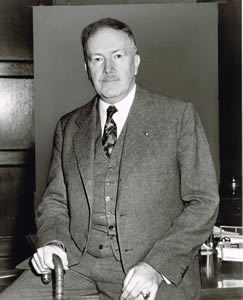Colonel
James L. Walsh
 Colonel James L. Walsh was born on May 6, 1885, in Boston, Massachusetts. After attending the Massachusetts Institute of Technology, Walsh graduated from the United States Military Academy with the Class of 1909. As a young officer, he invented an improved sliverless, smokeless-powder grain; the patent for which he gave to the United States government. Later, he was assigned to assist in the design of the disappearing carriage for the 16-inch gun; the largest in the world at that time.
Colonel James L. Walsh was born on May 6, 1885, in Boston, Massachusetts. After attending the Massachusetts Institute of Technology, Walsh graduated from the United States Military Academy with the Class of 1909. As a young officer, he invented an improved sliverless, smokeless-powder grain; the patent for which he gave to the United States government. Later, he was assigned to assist in the design of the disappearing carriage for the 16-inch gun; the largest in the world at that time.
In World War I, Walsh served as an assistant to two Chiefs of Ordnance; Major General William Crozier and Major General C.C. Williams. In 1919, Walsh was a driving force in the establishment of the Army Ordnance Association. He was a charter member of the organization and would serve on its Board of Directors until 1952. As well, in 1919, he was the founder and first editor of the association’s journal, Army Ordnance. While on active duty, Walsh served in Mexico, England, France, Belgium, Italy and Austria.
After retiring from the Army in 1922, he entered the banking profession. He became affiliated with the Banker’s Trust Company, New York, becoming assistant vice president in 1926. The following year, he was vice president and director of the McGraw-Hill Publishing Company and later served as vice-president of the National Bank of Detroit.
As a civilian, Walsh continued to promote industrial preparedness. He served as chief of the New York Ordnance District from 1923 to 1932, and subsequently became a member of the district’s advisory board. In addition, he served as chairman of the War Production Committee of the American Society of Mechanical Engineers from 1939 to 1945. In 1940, Secretary of War Henry L. Stimson (formerly general counsel of the association) appointed Walsh as Vice-Chairman of the National Technological Advisory Commission, which he served from 1940 to 1952. During World War II, he served as a special adviser to the Chief of Ordnance, Lieutenant General Levin H. Campbell. In 1941, in recognition of his contributions to the Army Ordnance Association, he was awarded the association’s Crozier Gold Medal for outstanding service to the nation in the field of industrial mobilization planning.
As president of the American Ordnance Association (formerly Army Ordnance Association) from 1947 to 1952, Walsh led the organization in its many technical and scientific activities, which earned its recognition as the leading professional society in United States dedicated to technical and scientific preparedness. During this time, the association comprised of more than 35,000 members, including many of the leaders of science and industry throughout the country.
On June 9, 1952, Walsh was presented with a special testimonial signed by Frank Pace, Jr., Secretary of the Army and General J. Lawton Collins, Chief of Staff of the Army in recognition of his contributions towards national preparedness. The testimonial was presented to Colonel Walsh at Walter Reed Hospital two days before his death. Colonel James L. Walsh died on June 11, 1952.